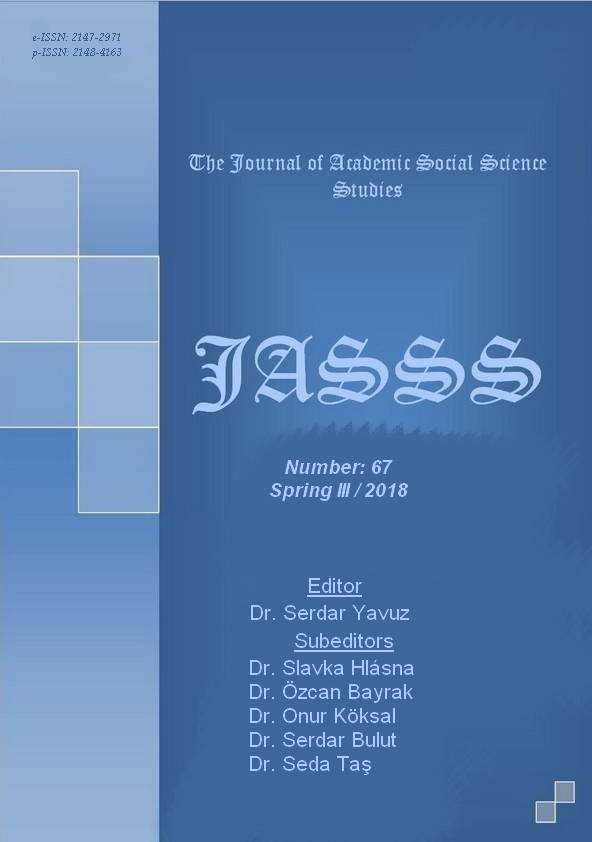İLETİŞİMSİZLİĞİN ABSÜRD TİYATRODAKİ TEMSİLİ: AZİZ NESİN’İN “BİR İNSAN BAŞI ÜSTÜNE ÜÇ SESLİ ÜZÜNÇ” ADLI KISA OYUNU
Author :
Abstract
" II. Dünya Savaşı sonrası insanlığın içine sürüklendiği olumsuz durumla birlikte, yaşam-birey arasındaki uyumsuzluğu yansıtmayı amaçlayan Absürd Tiyatro anlayışı doğar. Nesnel gerçeği kabul etmeyerek edebi metinlerde akıl dışı öğelerin rolünü savunan Dadaizm ve Sürrealizm ile insanın yaşamdaki yerini anlamlandırma çabası içinde bulunan Varoluşçuluk gibi sanat akımları Absürd Tiyatronun oluşumunda etkili olurlar. İlk olarak Avrupa’da örnekleri verilen bu tiyatro anlayışı, geleneksel tiyatronun alışılagelmiş bütün metin ve sahneleme özelliklerine karşı çıkar. İnsanın varoluş mücadelesinin, göreceli gerçeklik anlayışı ile kesiştiği bu tiyatronun kahramanlarını, uyumsuz-iletişimsiz, evrensel özellikler taşıyan bireyler oluşturur. Tiyatro metinlerinde kullanılan dil ise iletişimsizliği yansıtmada en büyük araç haline dönüşür. Görsel imgelerle desteklenen dil bütün sınırlarını zorlayarak anlatım aracı olma işlevini terk eder ve nesnel gerçekliğini yitirir. Bu durum ise Absürd Tiyatro metinlerinde iletişimsizliğin en büyük sembolü olan dili “anlam”ın karşısındaki temel çelişki konumuna getirir. Çalışmamıza konu olan Aziz Nesin’in Bir İnsan Başı Üstüne Üç Sesli Üzünç(1980) adlı oyunu, hem Beckettyen karakterleri ile umut ve bekleyiş eylemine gönderme yapan, hem de insana dair bütün duyguların dalgalanmalarını gösteren, beden ile dilin uyumsuzluğunu yansıtan absürd tiyatro metinlerine örnek olarak gösterilir.Bu çalışmada, Aziz Nesin’in Bir İnsan Başı Üstüne Üç Sesli Üzünç adlı oyununda Absürd Tiyatro etkilerinden bahsedilecek, bu tiyatro anlayışına özgü temalar, davranış ve anlatım biçimleri incelenecektir."
Keywords
Abstract
"Absurd Theatre, which aims to represent inconformity between life and individual, has arisen with the negative atmosphere for humanity pursuant to the Second World War. Art movements such as Dadaism and Surrealism, which defend the role of irrational items in literary texts without accepting objective truth, and Existentialism, which struggles to make sense of the place of human life in life, are influential in the formation of Absurd theater. This new perception of theatre gave the first examples in Europe and; it stands against all conventional text and acting characteristics of traditional theatre. In this theatre type, existence struggle of humanbeing coincides with relative reality perception. The heroes of this theatre are nonadaptive, have communication problems and universal characteristics. The language used in theatre texts is the most important tool to reflect the lack of communication. The language, supported with visual images, pushes all boundaries and moves beyond functioning as a narration tool and loses its objective reality. This case puts language, the biggest symbol of the lack of communication in Absurd Theatre texts, into a fundamental contradiction against ""meaning"". Play of “Bir İnsan Başı Üstüne Üç Sesli Üzünç” by Aziz Nesin is an example of absurd theatrical texts that refer to Beckettyen characters and hope and expectation actions as well as to show the fluctuations of all feelings about human beings, reflecting body and language inconformity It is shown.İn this study, the effects of the Absurd Theater will be mentioned in Aziz Nesin's play, the themes, behaviors and narrative styles specific to this theater understanding will be examined."





